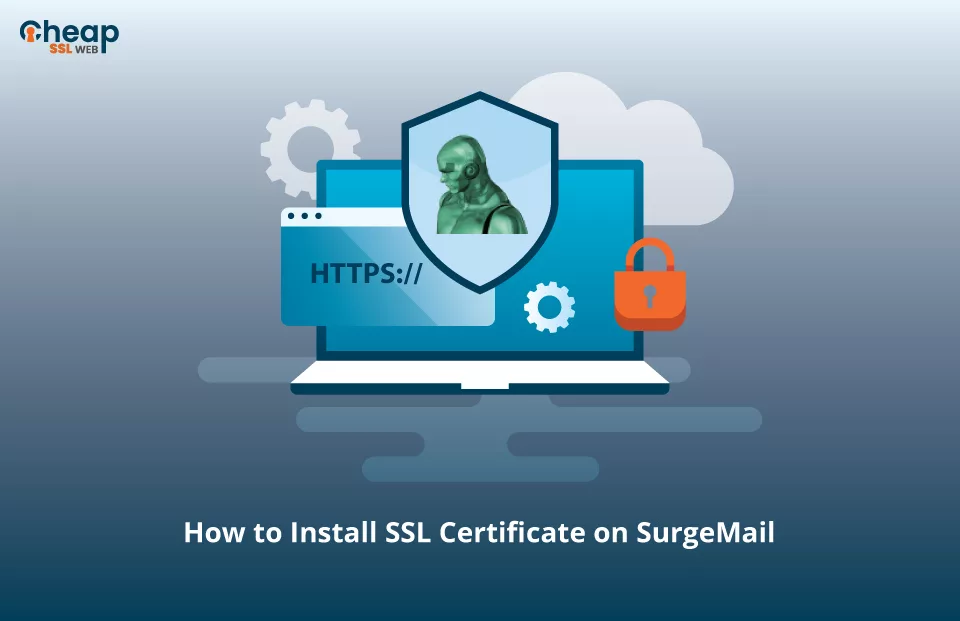How to Install SSL Certificate on SurgeMail?

Steps to Generate CSR and Install SSL Certificate on SurgeMail
Welcome to this tutorial, where you will acquire the knowledge to install an SSL Certificate on SurgeMail successfully. This tutorial is divided into three parts to understand the process comprehensively. We will guide you through CSR generation and SSL installation in parts one and two. Finally, in the last segment, we will unveil the ideal online destination for finding affordable SSL certificates. By the end of this tutorial, you’ll be well-equipped to protect your SurgeMail server with an SSL cert while being aware of the cost-effective options available. Let’s dive in!
How to Create a CSR (Certificate Signing Request)?
CSR is an encoded text submitted to a Certificate Authority to verify the identity of your company or website. When it comes to creating a CSR for SurgeMail, you have two options:
- Using our CSR Generation tool: This option allows you to save a lot of time as the whole process is automated. You just need to input the required details in specific fields and click Generate. This automated approach guarantees efficiency and convenience, enabling you to effortlessly generate both the CSR and private key without any hassle.
- Creating it manually: If you prefer to generate the CSR manually, it is crucial to exercise caution and ensure the accuracy of the information you enter. Double-check all the details to prevent any errors or misleading information. Remember, any inaccuracies can lead to the CA rejecting the issuance of your SSL certificate.
How to Install an SSL Certificate on SurgeMail?
You can follow a straightforward process that only involves five steps to install an SSL cert on SurgeMail, and here are those five steps:
- Unzip and extract the files.
- Copy the SSL certificate details on the text editor – (E.G Notepad).
- Copy the Intermediate certificate details on the text editor (E.G Notepad).
- Merge the contents of both the .crt files.
- Paste the contents of the certificate files to the SSL Certificate(s) field.
- Restart the SergeMail server.
Unzip and extract the Files.
Double-click the .zip folder and extract these certificate files:
- SSL certificate file
- CA Bundle (Intermediate certificates files)
- Private Key
Copy the SSL certificate details on the text editor – Notepad.
Open the SSL certificate files and copy the entire content, including “—–BEGIN CERTIFICATE—–” and “END CERTIFICATE—–” headers on a text editor file like Notepad with the .crt extension. (Assuming the name given is SSL_one.crt)
Copy the Intermediate certificate details on the text editor – Notepad.
Open the CA Bundle files, copy the entire content, as done in the previous step, and save it on a new Notepad file (.crt extension). (Assuming the name given is SSL_two.crt)
Merge the contents of both the .crt files
- Open a new Notepad file (ex – New_three.crt).
- Copy the entire content of the SSL_one.crt file.
- Paste the copied content into the New_three.crt file.
- Copy the entire content of the SSL_two.crt file.
- Repeat step 3 and make sure that there are no spaces between the content of SSL_one and SSL_two .crt files.
Here’s the format for your reference:
BEGIN CERTIFICATE—–
(Server certificate)
—–END CERTIFICATE—–
—–BEGIN CERTIFICATE—–
(Intermediate certificate)
—–END CERTIFICATE—–Paste the contents of the certificate files to the SSL Certificate(s) field
- In the Web Admin, in the SSL Certificate(s) field, copy the content of the New_three.crt file. To copy the content of the New_three.crt to this field, open the file in question in text format using WordPad or any other text editor.
- After successfully pasting the content in the SSL Certificate(s) field, click Save.
Restart the SergeMail server
Now, all that is left is to restart the SergeMail server and test your installation.
Test the Installation on the SergeMail Server
SSL connection errors can arise from server issues or browser complications, necessitating a thorough evaluation of both. Employing testing tools like Qualys SSL testing and SSL Checker Tool is highly recommended to address and rectify such potential concerns effectively.
Qualys SSL testing tools offer immediate reports encompassing crucial factors such as protocol support and handling mixed content. Leveraging this tool allows for swift identification of any vulnerabilities in your SSL configuration, enabling prompt remediation measures.
In addition to Qualys SSL testing, utilizing SSL Checker further enhances your ability to assess your SSL certificate’s installation status. The generated reports contain detailed insights, facilitating the identification of specific areas that may require attention. By promptly addressing any flagged issues, you can ensure a secure SSL configuration that optimizes performance and safeguards your website’s security.

